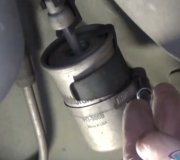Hi and thanks for using 2CarPros.com.
This is not an easy one. However, I will provide the directions to testing and inspecting. The diagnostic process will take some time. Also, I noted that you indicated "little knowledge". Take a look through the directions to make sure you are comfortable with proceeding.
Once you complete the diagnostic process, let me know what you find and I can further direct you on what and how to fix.
Just in case, here is a link that describes how to use a volt multi-meter. You will need to use one to check resistance/ohms.
https://www.2carpros.com/articles/how-to-use-a-voltmeter
Here is one for testing wiring:
https://www.2carpros.com/articles/how-to-check-wiring
_____________________________
Here are the directions. The attached pictures correlate with these directions.
Testing fuel gauge
Test values immersion tube transmitter in ohms
Model Resistance, readout full Resistance, readout reserve
107.04 3.2 ± 0.7 69.1 ± 2.1
107.02 3.2 ± 0.8 69.3 ± 2.5
Testing immersion tube transmitter (removed)
(pic 1)
Connect ohmmeter to terminal G and terminal 31 and measure resistance.
a) In installation position, (readout reserve, float below).
b) Rotated by 180°, (readout full, float at top).
Testing reserve warning contact
Connect ohmmeter to terminal W and terminal 31 and measure resistance.
a) Nominal value 0 ohm in installation position.
b) Nominal value infinite ohm turned by 180°.
Testing harness
(pic 2)
1 Pull coupler from immersion tube transmitter and measure resistance on jack 3 and vehicle ground.
Nominal value 0 ohm
(At test value infinite ohm the grounding line is interrupted).
(pic 3)
2 Measure resistance on terminal G and terminal 31 on installed immersion tube transmitter. Value depends on amount of fuel in tank.
Plug coupler back on immersion tube transmitter.
(pic 4)
3 Pull coupler from instrument cluster and measure resistance between jack 4 and jack 5 on vehicles with mechanical tachometer.
On vehicles with electronic tachometer between jack 4 and ground.
Nominal value: the value measured under 2. If the value is attained, the harness is in order (slight deviation caused by length of line possible).
(pic 5)
4 If the measured value is higher or at ohm, the harness couplers (on instrument cluster, on main harness/tail harness or on immersion tube transmitter) are having poor contact, a dry joint or a line is interrupted.
Indicating instrument
5 If no fault is found during tests, exchange indicator.
______________________________________
This is complicated, so feel free to let me know if you need help or just have questions.
Images (Click to make bigger)
Friday, November 16th, 2018 AT 8:22 PM







